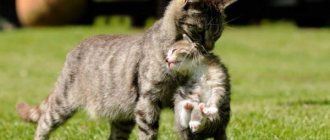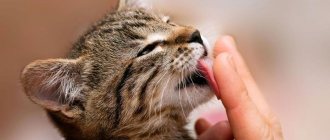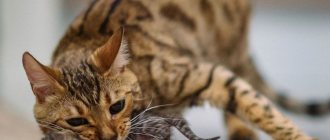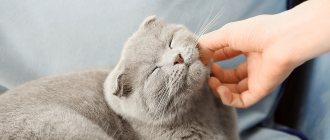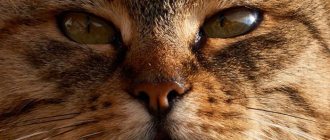Most often, a cat drags kittens in her teeth due to the fact that a person shows excessive attention and curiosity towards the babies. A young mother is worried about this behavior, and in order to protect her offspring from an annoying owner, she hides the babies, trying to hide in hard-to-reach shelters - under a sofa or closet, and sometimes even carries them outside the house. However, sometimes the reasons for this behavior can be more serious, for example, health problems with the kitten or postpartum eclampsia.
What to do in such situations?
So that the cat has no reason to worry and remove its offspring from the equipped nest, the owner should take the following measures:
You can prevent this situation by preparing and arranging a box for the expectant mother in advance.
- Prepare in advance a comfortable, safe place where the cat can give birth to babies. Usually a closed cardboard box and a soft, warm bedding are enough for this. Protect from other pets. Other cats and dogs should not look into the house. A new mother must be sure that nothing will happen to her babies. Maintain a comfortable temperature in the room. Keep the litter clean. For convenience, you can line the bottom of the box with disposable diapers, which you can replace with new ones when dirty.
The cat should feel supported by the owner. If an animal is worried and behaves unnaturally, there are good reasons for this and it is important to find out them as soon as possible. If you can’t figure out on your own what the pet is not happy with and why she drags the kittens from place to place, it is better to seek advice from a veterinarian. Sometimes, to determine an accurate diagnosis, a comprehensive diagnostic study will be required, after which adequate treatment will be prescribed.
What to do if your pet is carrying babies
Owners of young cats can observe the following situation: a pet that has lambed for the first time is dragging its cubs around. To avoid unpleasant consequences, the owner should take care of the pet in advance.
- Before giving birth, prepare a suitable place for the expectant mother to nurse. Observe your pet where exactly she feels most comfortable. Organize a nest in a place chosen by the cat.
- Agree in advance with household members that after lambing the animal will not be shown undue attention. A young mother should feel completely safe.
- Before giving birth, visit a veterinarian who will examine the pregnant woman and prescribe vitamins and dietary supplements to avoid postpartum eclampsia.
- Prepare in advance a convenient box or basket in which the cat can feed the kittens.
How to distinguish a male kitten from a girl: a newborn, in the first days of life
Under no circumstances should you scold or punish a cat carrying kittens. You should not independently carry babies hidden by their mother. Nature has instilled in females the instinct to preserve offspring. Violent actions on the part of humans can lead to the fact that the pet will stop caring for the cubs.
Warm, safe shelter for kittens is the main requirement for cats. Only in this case she will not drag the cubs around the house, looking for a more comfortable place.
A properly organized nest, proper care of the pet during pregnancy, and tact on the part of household members will help the cat raise healthy, strong offspring. If all conditions are met, she will not hide the cubs.
Cat owners often observe how their pets drag their cubs after lambing. There are many reasons why a cat takes kittens to another place: from excessive attention of people to babies to postpartum eclampsia. Finding out the true reason for this behavior is necessary to ensure the safety of the offspring.
Reasons why a cat hides her kittens securely
Excessive curiosity among family members
If household members are constantly looking into the shelter with kittens, and at the same time they are picking up blind, defenseless babies, it is natural that the cat is always tense and does not like this state of affairs. Until the offspring grow up, the cat must be sure that they are safe and that in the event of her short absence, no one will disturb the babies. If the animal is not sure of this, it will try to move the kittens from the nest to another, safe place, where the owner cannot disturb the peace.
The cat doesn't like the nest
Inappropriate box size, too bright lighting in the room, uncomfortable bedding, drafts are likely reasons why a cat takes kittens to another place. To prevent the animal from suddenly starting to carry its offspring to term, even before giving birth, the owner should take care of a cozy, secluded and comfortable nest. The cat needs to be familiarized with the new place. If she settles down there with pleasure, the pet will be spacious, warm, she will never want to leave this place and certainly will not carry and hide the kittens.
Postpartum eclampsia
This is a dangerous complication caused by calcium deficiency in the body of a new mother. An imbalance of important elements leads to excessive anxiety and even aggressiveness. If the owner notices that the cat is dragging kittens from place to place, and the pet has become strange and uncommunicative, it is better to take her to the veterinarian, who, after a series of diagnostic tests, will advise what to do next.
Sometimes the only option is to let the cat move the nest
If your cat is dead set on moving her nest, you may not be able to stop her! If she decides that her kittens are in danger, she may become stressed if she cannot move them. If you've tried all of these methods and she's still convinced that rehoming the kittens is the best option, you may just need to accept it.
As long as the new location is not dangerous, you may decide to help her by providing her with new, clean bedding, moving her food and water bowls, and even taking some of her kittens to the new nest.
Posted by Christian Adams An American expat living in Metro Manila, Philippines for over a decade, Christian is a lifelong cat lover and the proud father of two rescue cats, Trixie and Chloe. Both girls used to be among the crowds of homeless people who roam the cities and countryside. Three-year-old Trixie was rescued from a litter found under a neighbor's porch, and two-year-old Chloe was brought home by Christian's young son, Henry, who discovered the crying kitten in the parking lot.
How to reduce the likelihood of a kitten being transferred
To reduce the likelihood of kitten transfer, provide the mother cat with a dry, clean, cozy place (box) in a quiet, low-traffic area of the house.
You can buy a suitable box or make it yourself from cardboard, wood or a plastic container. We received a box from Nova Poshta.
You need to put a cloth or a tightly woven towel in the box. It is not recommended to use terry cloth, which will cause kittens' claws to catch.
Pay attention to the mother cat's body language and behavior with her kittens. She should be as relaxed as possible and not nervous.
A week or two after birth, most cats will allow kittens to be held, as long as they are held briefly and in plain sight. It is recommended to pick up kittens starting from the second week.
Thus, the kittens begin to become familiar with people. If you notice that the cat is worried when the kitten is picked up, then it is advisable to return it to its place.
Children can handle and play with kittens as long as the play is not loud or vigorous enough. Kittens must be kept extremely carefully.
It is also recommended to wash your hands thoroughly before handling kittens. Their immune system is not developed enough to fight harmful microorganisms. This can cause subsequent illnesses.
If the cat does drag the kittens, then it is advisable to leave them in the new place that she has chosen.
Again, avoid bright light and noise, and leave the cat and kittens alone. As soon as the cat calms down, you can continue caring for the offspring again.
Consequences
Having studied how and why cats carry kittens, you should also know the possible consequences of such actions. After all, this can be dangerous for kittens. Firstly, if the mother takes them to another place, the offspring may be injured. For example, when a mother drops her children from a height. Sometimes such a fall can lead to death. Secondly, injury can be caused by clenching the teeth while dragging the baby. When the kittens grow up, the female simply pulls their drags. All this can injure a fragile organism, and even worse, lead to death. It is forbidden to take kittens out of their mouths while they are being dragged. In this case, the clenching of the jaws will only intensify. Thirdly, if the mother often carries offspring, then there is a danger that she will forget the kitten or kittens. Without food and proper warmth, babies can die.
What should owners do?
- Firstly, the owner needs to limit the cat’s access to a place where setting up a “nest” would be unsafe (balcony, space under the bathroom, high shelves, ventilation).
- To prevent possible dragging of kittens, you should arrange several secluded places in advance (before the birth) so that the cat can choose where it will be more comfortable. The best option would be if a pregnant cat spends several nights in the selected “nest”. This way your pet will quickly get used to the place and feel more comfortable.
- After the birth takes place, be sure to protect the mother and her litter from prying eyes, because any intervention is a colossal stress.
- Observe the temperature regime of the room, the temperature should be as comfortable as possible.
- Remember that the room where the animals are located should not be too large.
- If a young mother nevertheless begins to carry kittens, she should under no circumstances be scolded. Keep in mind that the animal always obeys its instincts. At the moment of dragging, it is strictly forbidden to take the kittens from the mother’s mouth. The cat will strive to protect the litter, and the clenching of the jaws will intensify, this can injure the baby.
- Keep a close eye on the cat while moving the kittens. While dragging the baby, she may simply forget where she hid him again. Be prepared, because a kitten, left alone, may die, especially if it is still very small and blind.
Why does a pet hide kittens?
According to reports from owners of first-born cats, the mother often hides her offspring due to her inexperience. A young cat does not yet know what to do with babies who squeak pitifully. The frightened female begins to drag and hide the kittens.
The owner should properly organize the shelter (prepare a convenient box, calm the cat, protect the household from curiosity).
Another reason for hiding is the illness or poor health of one of the cubs. The owners observe the following picture: the cat drags the weakest kitten around the room, looking for an opportunity to accommodate it in the best possible way. Having found a place that is safe, from the animal’s point of view, the mother brings the others there in her teeth.
What should an owner do when a cat carries kittens?
Even during the period of bearing offspring, the owner must ensure that the expectant mother is satisfied with the “maternity hospital” he has equipped. It would be better if it was a spacious box with low sides. It's called a nest. The place should be warm, without drafts, not too lit, quiet. The box should be ready about a week before the birth so that the cat can sniff everything and adapt to it. If a pregnant woman spends several nights in a nest prepared by the owner, this reduces the risk of subsequent dragging of offspring by the cat.
Never take kittens from their mother by force! Such actions can negatively affect the pet’s psyche. After all, after giving birth, she experiences stress. Just block access to places where the mother should not go with her kittens, for example, to the closet. If a nursing pet has chosen a secluded corner under the radiator, then help her make it more comfortable: put some bedding and block it with something.
The best place for kittens
To prevent the cat from dragging the babies around the room after giving birth, you should think about the location of the family in advance. To do this, it is necessary to prepare 3-4 nests a few days before lambing, let the furry mother choose the most suitable one herself. They need to be installed in a quiet room with shade. Places can be placed in the corners of the room to make the cat feel protected. It is advisable that there are no other animals nearby, the room is quiet and calm. Sometimes the best option, especially in apartments with children, is a wardrobe.
In any case, the place where the cat can hide the kittens should be dry, warm, and safe. Only in this case can we hope that it will suit the caring mother, and she will not look for another and drag the cubs.
To build a cat's nest, a cardboard box of the appropriate size is suitable. It can be lined with fabric and baby disposable diapers can be placed on the bottom. An exhibition tent is also perfect. It can be closed, which will prevent kittens from being dragged around at night and accidents to the cubs.
When the cat rolls, it will choose a place for itself from the nests pre-arranged by the owner. After this, fallback options must be removed.
The birth of kittens, feeding, caring for helpless animals, their protection and care are the natural instincts of any domestic cat. It is necessary for a person to interfere with these natural processes only if, for some reason, the cat is not satisfied with external conditions. In this case, the animal needs to be helped unobtrusively and delicately. This will not only reassure the new mother, but will also save the lives of the babies.
There are many reasons why cats eat their kittens. They are based on natural instincts. . As a rule, the female hides her nest from outside animals. But often a cat finds it and destroys the offspring.
Carefully observing the relationship between a cat and kittens, owners often notice that the pet does not show very warm and tender feelings towards its cubs. Reasons why cats bite their kittens.
From it you will learn about the reasons that force mothers to hide kittens, the undesirable consequences of such behavior, and what owners should do in this situation. . Why is a cat skinny, reasons why a cat is not.
If for some reason the nest was not prepared, then the first thing they should do is. The tray should also be located close to the box with the kittens so that the cat can safely go to the toilet without fear of leaving the cubs for a long time.
Kitten nutrition
Pregnancy
Any cat owner will tell you that pregnant cats sometimes behave very strangely and illogically from a human point of view.
During pregnancy, the animal's instincts, which have been ingrained over the centuries-old history of evolution, become more acute. The owner should take care of the pet rushing around the house in search of shelter and build a similar nest for the animal. The best option would be a regular TV box with some warm fabric at the bottom that absorbs moisture. Then the owner will not have to scour the house, looking for a hard-to-reach corner with helpless newborn kittens.
We suggest you read: How to wash a kitten for fleas? What shampoo and how often should I bathe him?
Pregnant cats can sometimes remain affectionate and flexible, still easily communicating with their owners, but most often these ladies are irritable and show aggression for any reason, meowing and hissing at their pets. Therefore, it is very useful to rid pets of annoying children’s attention, pestering and all sorts of harsh sounds, because the animal is already constantly tense and on the verge of exhaustion.
My cat's whiskers are falling out: why and what to do?
Cat instincts and behavior
The habits, behavior and habits of pets are largely dictated by natural instincts and skills. What is the reason and why does a cat drag kittens from one place to another?
There may be several reasons why a cat may drag its kittens:
- The cat has no experience in motherhood and is constantly looking for more suitable places when carrying kittens.
- The conditions created by the owner for the cat and kittens are not suitable for the living and raising of animals. The female tries to move the kittens to other places in the house that, in her opinion, are more suitable for them. It's warmer, quieter, more comfortable and dry there.
- If a cat carries kittens by the withers, this may be considered specific to her breed. For example, a representative of the Bengal cat breed carries a kitten in her teeth in order to protect and hide it from potential predators and enemies.
- The cat carries older kittens so that they are closer to food resources, where the cat itself is usually fed.
- The cat carries the kittens for fire and life safety purposes, so that nothing bad happens to them.
- A particular cat disease is eclampsia, which can occur during the first month after birth. The prerequisites for the occurrence of disease in an animal may be poor living conditions, lack of calcium, genetic disorders and changes in metabolism.
READ Ball under the skin of a cat
Among the particularly severe symptoms of feline eclampsia, when a cat drags kittens in her teeth, may be a prolonged aggressive and nervous state of the animal, heavy and rapid breathing, tremors of the head and limbs. With eclampsia, a cat carries kittens several times in a row, continuously doing this. The disease is treated in a hospital setting under the supervision of an experienced veterinarian.
Reason for changing registration
There are pets who are overly concerned about their children. They move away a little from giving birth and begin to constantly drag their offspring, finding new habitats every day. Before you find out what the owner should do in such cases, it is worth familiarizing yourself with the reasons for this behavior of the mother:
- The mother is not satisfied with the place chosen by the owners. It may be too hot (the box is under the radiator) or, conversely, very cold; insufficiently protected; too crowded (for example, this is the kitchen, where there are always a lot of people). Also, an area of the house that is too bright may not suit the mother cat. In the latter case, she will drag her offspring into the closet, where it is darker.
- Mom's inexperience. We are talking about first-born cats. They still don’t understand why their babies squeak. Not knowing what to do, such mothers begin to drag their kittens to other places.
- Eclampsia. This is the most serious and dangerous reason for such actions by a new mother. The disease can occur within a month after birth. Its causes are a deficiency or excess of calcium in the body, metabolic disorders or poor nutrition during pregnancy. Eclampsia in females is manifested by nervousness, which turns into aggressiveness, and heavy breathing. A mother with this disease will constantly move her babies to other places. She can bite them. If you suspect eclampsia, it is important to immediately seek help from a cat doctor, otherwise the cat may even die.
- Breed specificity. Representatives of some breeds have a well-developed protective instinct. It manifests itself precisely in excessive guardianship over the offspring, in attempts to drag them into dark places inaccessible to the owners. This is what Singaporeans and Bengal cats do. In this way, they seem to throw predators off the scent and protect the cubs.
If a mother constantly drags her very young kittens around, then such actions can have serious consequences for them. For example, jumping from a height, jumping over the high side of a box, a mother can drop her baby. By holding a child tightly by the withers, a cat can injure him. That is why it is strictly forbidden to forcibly snatch kittens from their mother’s mouth. It also happens that a cat drags each cub to different places and forgets where exactly she hid it. This way the baby can die, especially if he is still blind.
What can happen when dragging babies
If a cat constantly drags babies in her teeth, looking for a more reliable place for a nest, the following dangers await the kittens:
- During the transfer process, the kitten may fall, damage limbs, and receive serious injuries.
- While dragging, the cat may damage its withers by biting too hard.
- While hiding the kitten, a young mother may forget where the next hiding place is. A weakened, sick baby will die without maternal care.
Possible risks
Transporting still fragile babies is unsafe, and in this case various tragic accidents are possible:
- Jumping over high obstacles or climbing to heights, a cat can drop a tiny baby and it will be injured.
- A cat sometimes clenches its teeth too tightly, for fear of dropping its load, which harms the kitten’s skin.
- When choosing a better place, the cat can take the kids to different places and even forget where each “cat child” is. This is especially dangerous for newborn babies.
- A place carefully chosen by mommy may be completely unsafe.
Naturally, no one is immune from tragic accidents, but owners should listen to the opinion of the pet. Even before giving birth, you can take a closer look at which place the “lady in labor” has chosen, and, if possible, install the box there. And most importantly, you cannot drag kittens if they are not in danger, as this will negatively affect the mental state of the pet who gave birth.
Is it normal for cats to hide their kittens?
It is completely normal for cats to hide their kittens. All cats, wild or domesticated, have intuition. Their ancestors were wild cats, and young wild cats have many natural predators.
Historically, wild cats would change nests and hide their young again two or three days after birth. This should have confused any predators. The pungent smell of recent birth can attract hungry predators.
Although your pet trusts you, do not be offended if he rejects your advances or even the nest you have prepared. They act on their instincts and reach out to you again.
Keep the nest clean
Cats will instinctively want to keep their kittens clean. This is because the strong smell can attract predators in the wild and this will endanger the lives of her kittens. If the nest becomes dirty, she may begin to try to move her kittens to a cleaner area.
Remove dirty blankets, thoroughly clean litter boxes, and clean up spilled food daily. If the nest and surrounding area are kept as clean as possible, the cat will be more likely to stay in the same place and not carry the kittens around.
Why does a cat not like her kitten area?
A cat is dragging a ginger kitten.
We are sure that you have spent a lot of time and effort to arrange a beautiful and cozy place for “Murka” where she could give birth to kittens. But as they say: “not a fact and again not a fact.”
The cat has its own vision of the best place for its offspring. Most cats prefer a quiet and safe place. Accordingly, in such a place she and her kittens will remain alone.
You should know that newborn kittens are completely dependent on their mothers, and cats take their role very seriously.
If your “Murka” gives birth in a place where there is a lot of noise, bright light or other movement, then there is a high chance that she will look for a more secluded place.
Even if the initial place for birth was “agreed” with the cat, it may change later. Common options are behind or under sofas, chairs and beds, and in drawers or cabinets.
We're just playing!
Cats are known to be very mischievous! These pets never get bored and always find something to do. And the favorite pastime of these indoor predators is unexpected attacks from ambush, which is perfect for the hidden spaces under the bed or behind the closet! Kittens and young pets are especially happy with such games.
Those who are just beginning to experience the delights of living in the same house with a cat should know and remember that their tailed and mustachioed friend is a predator who loves to ambush other animals in natural conditions. Therefore, if you find a cat sitting in a dark corner, you should think, maybe he’s just lying in wait for his next “victim”
And it doesn’t matter that she happens to be a family member passing by
In such cases, it is important to do everything to prevent the animal from ambushing in places where it is dangerous for it to be. For example, in ovens, washing machines or dishwashers, you need to pay a lot of attention to cabinets and bedside tables with closing doors - what if you got into them? Otherwise, he won’t be able to get out, and it’s good if the owners are at home and save the hunter from captivity
How to diversify your cat's diet
You cannot feed your cat only meat and meat products. It is very useful to supplement his diet with a variety of cereals (rolled oats, buckwheat, rice, millet). You need to boil porridge in water, although you can use broth from lean meat. Experts recommend adding a little natural vegetable oil to this mixture, this improves the functioning of the animal’s intestines.
Low-fat fermented milk products are also beneficial for domestic cats - yogurt without additives, kefir or sour cream with a fat content of no more than 9%. Contrary to popular belief, milk is absolutely not healthy for cats, and sometimes even harms digestion.
For your pet’s well-being, it is better not to mix meat and dairy products, for example, give porridge with meat and vegetables at lunch, and a bowl of low-fat yogurt or yogurt in the evening.
Cats love domestic eggs, but they should not be given in large quantities either; excess protein can lead to health problems. A raw quail egg can be offered to the cat as a whole, but only the yolk can be given from a boiled chicken egg.
Is it possible to give raw meat to a cat, and what should it be combined with? Vegetables are great. Your pet's diet can be quite varied. If taught from an early age, the cat will eat boiled vegetables (beets, carrots, cauliflower, zucchini) well. They are mixed with meat or boiled fish.
However, there are quite serious restrictions on mixing feed and natural nutrition.
Types of “safe” meat for cats
More than 80% of a cat's daily diet is meat. But, before feeding your mustachioed pet this product, you need to figure out which types of meat will be beneficial for the cat’s health and which types of this product can cause serious harm to the body.
First of all, you should focus on the following rules:
- the meat must be fresh;
- low-fat;
- without small and dangerous bones;
- no unpleasant odor.
You need to feed your cat high-quality meat, and not waste product that is not useful on the human table. From time to time, your pet can be pampered with offal and cartilage, always fresh and low-fat (no more than 200g per week).
To feed your cat, you can buy chicken, quail, lean lamb, beef, rabbit, turkey, horse, goat and beef.
Pork, duck, goose and fatty lamb are prohibited.
Now let's figure out in what form meat can be served to a domestic cat.
Grilled meat
Fried product is strictly prohibited for feeding domestic cats. After eating such meat, the animal may experience serious problems with the liver, stomach and other organs of the digestive tract. All this will lead to a lot of unpleasant health problems for the pet and will significantly shorten its lifespan.
Cooked meat
This meat can be given to a cat. It contains many nutrients that are beneficial for her body. The main thing is to cook the meat correctly: boil it in low-fat broth without salt and other spices.
And one more rule: you cannot give raw and cooked meat at the same time.
To digest these foods, the body will need to produce different enzymes, which will negatively affect the digestion process. This may manifest itself as vomiting, stool disturbances and other unfavorable symptoms.
Smoked meat
Smoked meat is very dangerous for the body of a small predator. It is unacceptable to feed your pet such a harmful product!
Raw meat
Raw meat is a natural food for domestic carnivores. In their natural environment, cats always feed on prey consisting of small rodents and birds. It’s clear that they consume their catch raw, without cooking.
To create a complete diet for a mustachioed pet, experts recommend combining meat with other healthy foods. For example, you can serve it with vegetable puree and olive oil. Or prepare a delicious soup from low-fat broth with herbs, butter and pieces of meat.
- fresh meat should be cut into pieces, distributed into bags in small quantities for one feeding and sent to the freezer for freezing;
- Meat should be frozen for 3-4 days or more;
- extreme cold destroys helminth eggs, which makes the meat product absolutely safe to feed cats;
- Before serving, the meat can be slightly warmed in the microwave or poured boiling water over it;
- It is better to defrost the product in a plate; after defrosting, juice from the meat will remain in it, which your furry friend will also happily sip on;
- Sometimes you can pamper your cat with raw minced meat, prepared yourself from fresh lean meat, without salt and spices.
How can I stop my cat from hiding her kittens?
It is an instinctive trait of a mother cat to hide her kittens, so it can be a difficult habit to break. However, there are some things you can do to prevent your cat from hiding her kittens.
It is best to keep your distance if you are sure they are in a safe and secure location. Stay in touch if any problems arise. Your cat is an intelligent animal and will ask for help if she thinks she needs it.
You can also help your cat by providing her with a nest in the form of a warm, cozy box with one entrance lined with thick cloth and newspaper. Avoid using terry towels, as the fibers can get caught in kittens' claws.
If you don't disturb the new family, there's a good chance your cat will stay put. As mentioned earlier, your cat may hide her kittens if she feels she doesn't have privacy.
Try to make sure there is little noise or traffic around the nest. Keep children and other pets away from the cat. Although your cat may not normally have an aggressive personality, too much attention can make a protective mother aggressive in the short term.
Signs of a physical illness
Although animal psychologists are sure that in most cases, hiding in a secluded place is associated with the character of the cat, one should not discount such an unpleasant factor of such behavior as the presence of pathological processes in the body. This is especially true in cases where the habit arose suddenly, although the cat had not done anything like this before. That is why the owner must know which behavioral reactions are characteristic of his animal and which are not.
Veterinarians advise owners who are concerned that their furry friend has begun to hide in a dark corner to pay attention to such painful symptoms that appear in parallel, such as:
- The animal does not eat anything for a long time.
- Uncontrollable thirst or, conversely, the pet practically does not drink water.
- The pet began to sleep for a long time.
- Problems with the gastrointestinal tract in the form of diarrhea.
- The cat is vomiting severely.
- The appearance of the coat deteriorates, loses color, and the fur becomes lumpy or falls out.
